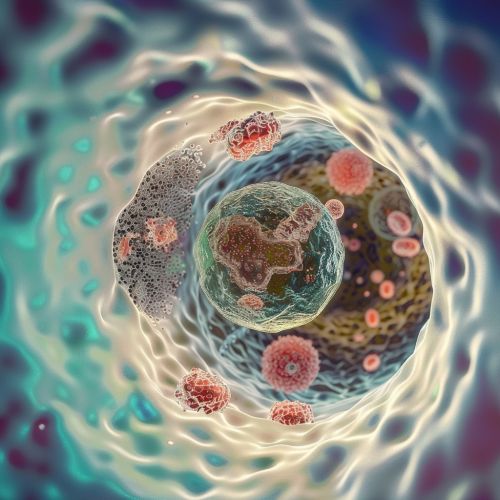Intracellular Receptors: Difference between revisions
(Created page with "==Introduction== Intracellular receptors, also known as cytoplasmic or nuclear receptors, are a class of proteins found in the cytoplasm or nucleus of a cell that are capable of binding to specific molecules, known as ligands. These receptors play a crucial role in the regulation of gene expression and are involved in numerous cellular processes, including cell growth, differentiation, and apoptosis....") |
No edit summary |
||
| Line 2: | Line 2: | ||
Intracellular receptors, also known as [[Cytoplasmic receptor|cytoplasmic]] or [[Nuclear receptor|nuclear receptors]], are a class of proteins found in the cytoplasm or nucleus of a cell that are capable of binding to specific molecules, known as [[Ligand (biochemistry)|ligands]]. These receptors play a crucial role in the regulation of gene expression and are involved in numerous cellular processes, including cell growth, differentiation, and apoptosis. | Intracellular receptors, also known as [[Cytoplasmic receptor|cytoplasmic]] or [[Nuclear receptor|nuclear receptors]], are a class of proteins found in the cytoplasm or nucleus of a cell that are capable of binding to specific molecules, known as [[Ligand (biochemistry)|ligands]]. These receptors play a crucial role in the regulation of gene expression and are involved in numerous cellular processes, including cell growth, differentiation, and apoptosis. | ||
[[Image:Detail-79053.jpg|thumb|center|A microscopic view of a cell showing the nucleus and cytoplasm. The intracellular receptors are highlighted.]] | |||
==Structure and Function== | ==Structure and Function== | ||
Revision as of 18:35, 16 May 2024
Introduction
Intracellular receptors, also known as cytoplasmic or nuclear receptors, are a class of proteins found in the cytoplasm or nucleus of a cell that are capable of binding to specific molecules, known as ligands. These receptors play a crucial role in the regulation of gene expression and are involved in numerous cellular processes, including cell growth, differentiation, and apoptosis.

Structure and Function
Intracellular receptors are typically composed of several domains, each with a specific function. The main domains include the ligand-binding domain (LBD), the DNA-binding domain (DBD), and the activation function (AF) domain. The LBD is responsible for recognizing and binding to the ligand, while the DBD binds to specific DNA sequences, known as hormone response elements, in the promoter region of target genes. The AF domain is involved in the recruitment of transcription factors and other regulatory proteins necessary for gene transcription.
Types of Intracellular Receptors
There are several types of intracellular receptors, each with its own unique set of ligands and target genes. These include steroid hormone receptors, retinoid receptors, thyroid hormone receptors, and peroxisome proliferator-activated receptors.
Mechanism of Action
The mechanism of action of intracellular receptors involves several steps. First, the ligand enters the cell, typically by passive diffusion across the cell membrane. Once inside the cell, the ligand binds to the receptor, causing a conformational change that allows the receptor to translocate to the nucleus. In the nucleus, the receptor-ligand complex binds to hormone response elements in the DNA, leading to the recruitment of transcription factors and the initiation of gene transcription.
Role in Disease
Abnormalities in intracellular receptor function can lead to a variety of diseases. For example, mutations in steroid hormone receptors can result in hormone resistance syndromes, while overexpression of certain nuclear receptors has been implicated in various types of cancer. Additionally, intracellular receptors are important targets for many drugs, including hormone therapies and anticancer drugs.
Future Directions
Research on intracellular receptors continues to be a vibrant field, with many unanswered questions. For example, it is still not fully understood how these receptors are able to recognize and bind to such a diverse array of ligands, or how they are able to regulate such a wide variety of genes. Moreover, the development of new drugs targeting intracellular receptors holds promise for the treatment of a wide range of diseases.
